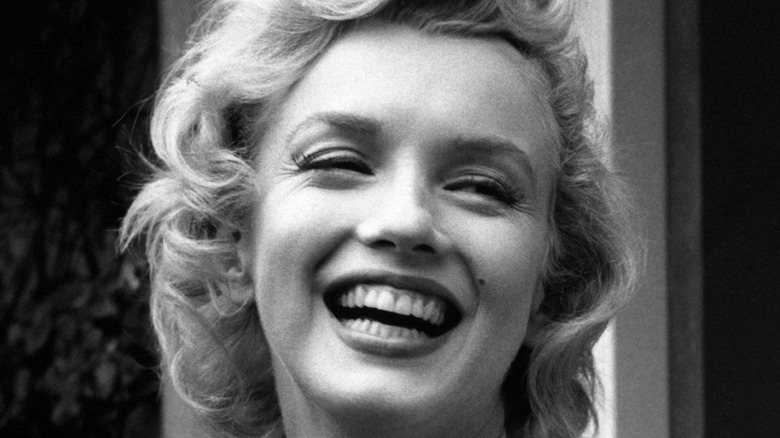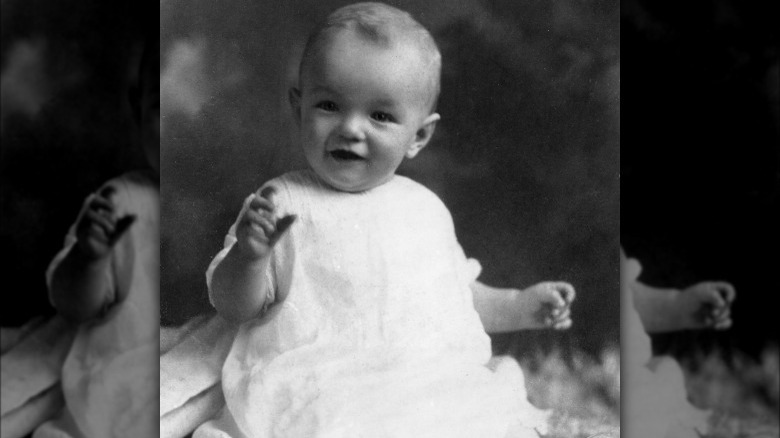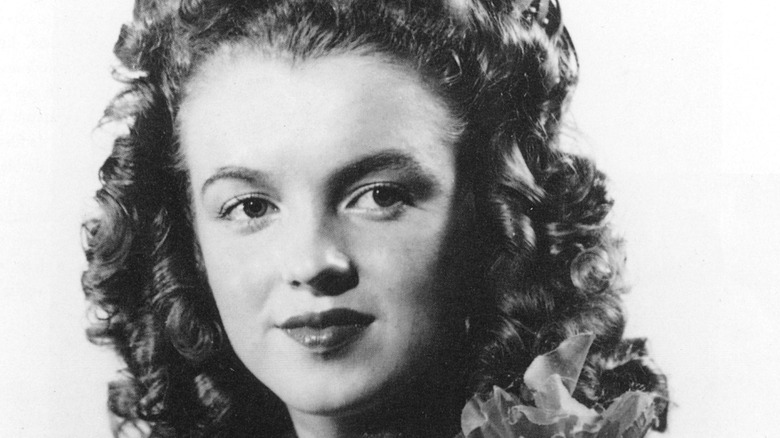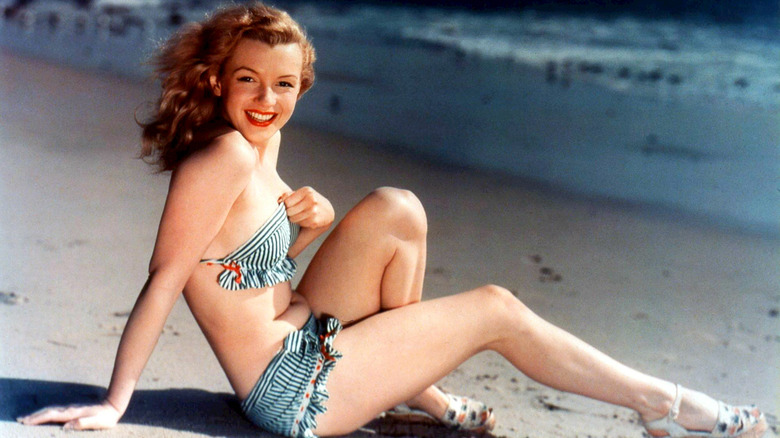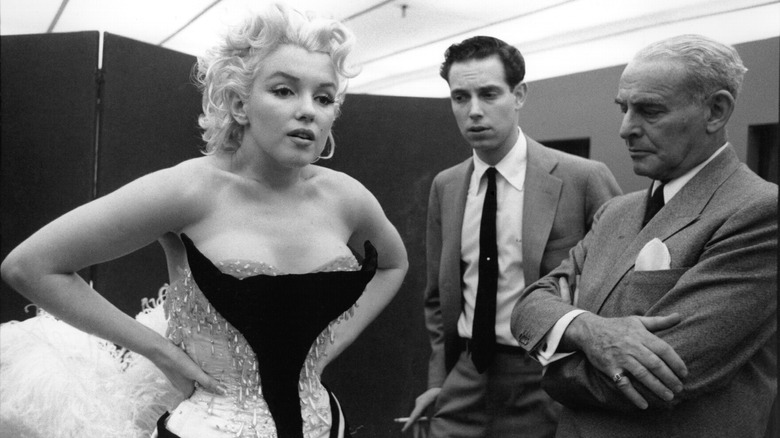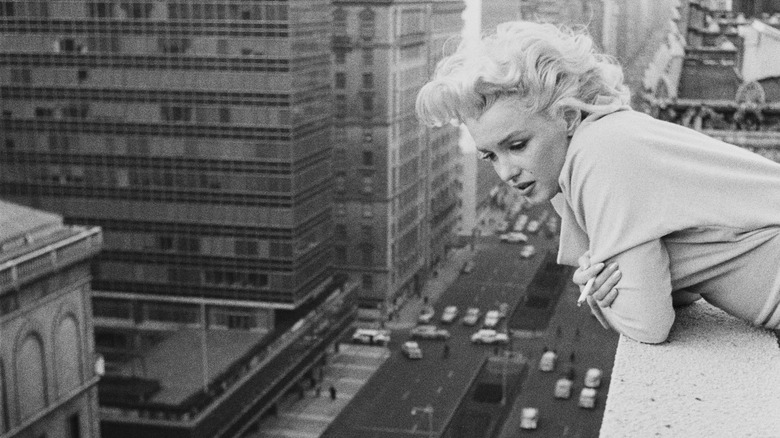The Tragic Story Of Marilyn Monroe's Mother
When Marilyn Monroe died of a sedative overdose in 1962, her death became a cautionary tale about the destructive forces of fame and success. The day after she died, Variety's opening line read, "Marilyn Monroe, who often tried without success to shut herself off from the world, early yesterday did so." Monroe's fame had careened so high, so fast, especially following her role in 1955's "The Seven Year Itch," that she might have had little recourse but to escape the globe's incessant attention. And yet to this day, much as back then, many folks wonder if there wasn't some other, more sinister and conspiratorial reason that she died.
In such a grand, nearly mythological narrative, it's important to remember that Monroe, born Norma Jeane Mortenson in 1926 in California, grew up a child like any other. She had a mother, Gladys Pearl Baker, who raised Monroe on her own while suffering from schizophrenia, as All That's Interesting recounts. That mother gave her daughter away, and then that same mother watched her daughter become internationally famous, and then watched her die. Baker would outlive Monroe by more than 20 years, and die of heart failure in 1984.
But who was Gladys Pearl Baker, really, and what was the true nature of her strained relationship with her daughter? Because of Monroe's star-studded status, we've got answers that go into detail far beyond that of many other people. And all of these answers, sadly so, are horribly tragic and heart-breaking.
A broken home and abusive marriage
While we don't know much about Gladys Pearl Baker's childhood, we know enough about her adolescence and early adulthood to see that she suffered tremendously, both from near-poverty and an undiagnosed mental illness, schizophrenia. Add to this her marriage at the age of 16 to 24-year-old, abusive husband John Newton Baker, and we can start to understand why she'd choose to give away her daughter, Norma Jeane, to foster care, only two weeks after the child was born in 1926 (via All That's Interesting and Biography).
Baker had had two children, Jackie and Berniece, with her husband before they got divorced in 1923, meaning that Marilyn Monroe had two half-siblings. Baker received custody of her children, but her ex-husband apparently kidnapped them and fled to Kentucky. Baker, by then locked into a self-destructive cycle, either stayed behind in California or moved there (this part is unclear), and briefly remarried to one Martin Edward Mortenson, from whom Marilyn Monroe gets her legal, non-stage last name. Baker was sure that Mortenson wasn't the father, though, and she claimed that Monroe's father was a co-worker at Consolidated Studios, Charles Stanley Gifford. Baker and Mortenson separated after mere months, and Monroe's paternity remained unclear her entire life.
Monroe grew up those early years in a stable, happy, highly religious home with her foster parents, Ida and Wayne Bolender, in Hawthorne, California. Meanwhile, her mother Baker barely made ends meet as a film cutter at RKO Radio Studios in Hollywood.
Kidnapping her own daughter
Baker wanted to play an active role in her daughter's life, but not in a healthy, productive way. As All That Interesting quotes friend-of-the-family Mary Thomas-Strong, "The truth was that Gladys [Baker] had a problem watching Ida raise her child." Baker was possessive, and visits to the Bolender household and sleepovers at her own apartment quickly turned dangerous. One absurd, almost unbelievable story describes Baker showing up at the Bolender's when Monroe was three, stuffing Monroe in a duffel bag, and locking Ida outside before attempting to escape. Ida managed to stop the kidnapping attempt (via Biography).
Over the following years Baker continued to request that the Bolenders return the fostered Monroe to her. They refused, and Baker tried to get herself together. By the time Marilyn was seven, Baker had gotten a loan for a house and taken in actors George and Maud Atkinson to help cover costs. This brief upturn in fortune came to an end that same year, in 1933. Baker received news that her son from her first marriage, Jackie, had died, almost the same time that she learned her grandfather had hanged himself and her entire studio was going on strike.
A year later in 1934 she suffered a nervous breakdown. Reports describe her wielding a knife in public and claiming someone was trying to kill her. The police dragged her away "kicking and screaming wildly" to a state hospital in Norwalk, California. There, she was institutionalized for the first time.
Foster homes and hospitalizations
This is where things get truly horrific not only for Baker, but Monroe. Monroe's foster care passed to Baker's friend, Grace McKee. It's then, as All That's Interesting describes, that Monroe's celebrity aspirations started to take off. McKee was a busy lady, however, and asked a judge to grant Monroe "half orphan" status, which allowed her to live intermittently with other caregivers. While Monroe passed between 10 homes and one orphanage from 1935 to 1942, Baker passed between hospitals. Monroe was sexually abused during this period, and saw her mother only now and then.
Monroe married James Dougherty in 1942 at the age of 16, the same age her mother had married her first husband. Monroe's marriage lasted four years. The same year it ended, 1946, Baker was released from San Jose's Agnews State Hospital, as Biography explains. She said that she was going to move to Oregon to live with her aunt, but instead married an already-married man, John Stewart Eley, who had a wife back in Idaho. Monroe and Baker were seeing each other a bit at this point, and when Monroe tried to warn her mother about her new husband's other marriage, Baker said, "That's how much [Norma Jeane] hates me ... She'll do anything to ruin my life because she still believes I ruined hers." Baker also disapproved of her daughter's career choice. Monroe's career was taking off, however, and her studio wanted to bury any information about their new star's mother.
The lie comes to light
Monroe, beginning to star in films come the late 1940s and early '50s, went along with the story that 20th Century Fox urged her to tell, via All That's Interesting: Her parents had died and she was an orphan; she had no idea who they were. As The Hollywood Reporter says, this led to no less than five women falsely claiming to be Monroe's mother. Gladys Baker, meanwhile — then Gladys Baker Eleys, from her marriage to the already-married John Stewart Eley — was going around saying the same thing, and no one believed her.
In 1952, a columnist found Eley working at a nursing home in Eagle Rock outside of Los Angeles. The story blew open, and Monroe confessed to it being true that Baker was her mother. When the story hit the news, Eley suffered another mental breakdown. This time, she was institutionalized in Rockhaven Sanitarium in La Crescenta, California. The next year, in 1953, Monroe's career exploded with her role in "Gentlemen Prefer Blondes."
From then on, even as Monroe's fame skyrocketed, her mother wrote letter after letter to her begging to be released from Rockhaven. Monroe reportedly visited the sanitarium before her mother was admitted, and found the whole place highly disturbing. Rather than have direct contact, Monroe sent her mother a monthly allowance. She also left Eley $5,000 a year in her will from a $100,000 trust. Eley lived in Rockhaven all the way through her daughter's death in 1962.
A history of mental illness
In 1961, the year before Monroe died, she confessed to having suicidal ideations. Like her mother before her, she was committed to a facility – Payne Whitney Clinic in New York. The press caught wind, the story aired on TV, and Gladys Baker Eley was found in her room with her left wrist slit, as Biography states.
A year after Monroe died, Eley climbed out of a window at Rockhaven Sanitarium. As Glendale News-Press explains, the then-60-year-old Eley made a rope out of two uniforms, lowered it to the ground through an 18-inch-square closet window, and got down. She climbed a wire mesh fence around the sanitarium and walked 15 miles to a church on Foothill Boulevard, where she huddled near a water heater for warmth in the church utility room. When the police found her, she said that she'd run away to practice "Christian Science teaching," as All That's Interesting says. They deemed her non-threatening and took her back to Rockhaven. Some point later she was released and moved to Florida, where she died of heart failure in 1984.
Some have speculated that Monroe inherited an unspecified mental illness from her mother, though Monroe was never diagnosed. WebMD does confirm that there is a genetic component to mental illness, although shared environmental factors between parents and offspring make it hard to suss out. Monroe's life is set to be explored further in the soon-to-be-streamed, Ana de Armas-led "dark biopic," as Decider calls it, "Blonde," on Netflix. (The trailer is posted on YouTube.)
If you or anyone you know is having suicidal thoughts, please call the National Suicide Prevention Lifeline by dialing 988 or by calling 1-800-273-TALK (8255).
